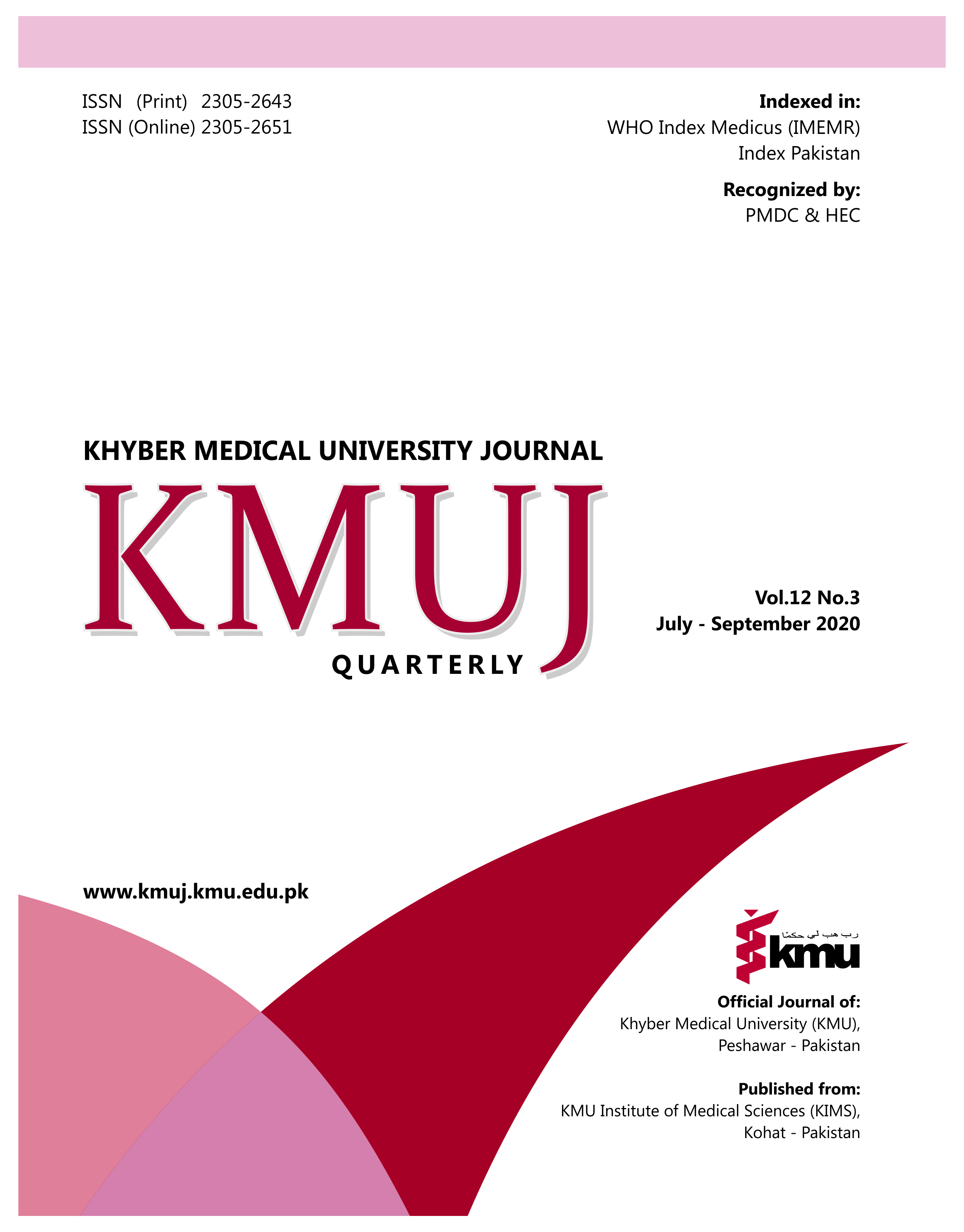COMPARISON OF SHOULDER PAIN, DISABILITY AND RANGE OF MOTION IN DIABETIC AND NON-DIABETIC PATIENTS WITH FROZEN SHOULDER
Main Article Content
Abstract
OBJECTIVE: To compare the shoulder pain, disability, and range of motion in diabetic and non-diabetic frozen shoulder (FS) patients.
METHODS: This cross-sectional study was conducted from December 2018 to June 2019 on 210 clinically diagnosed patients of FS. Study included equal number (n=105) of diabetes mellitus (DM) patients and non-diabetic patients, ranging in age from 35 to 65 years. Non-probability purposive sampling was used to assemble the data from various private and government hospitals of Lahore. A plastic goniometer and shoulder pain and disability index (SPADI) tool was used to extract data. Data was analyzed through SPSS v.21.0.
RESULTS: In 210 patients with frozen shoulder, the mean age was 53±10.3 years & 48±9.9 years in DM & non-diabetic patients respectively (p=0.94). Frequency of male & female patients was 43 (40.95%) and 62 (59.05%) in diabetic group (n=105) & 38 (36.19%) and 67(63.81%) in non-diabetic group (n=105) respectively. Mean body mass index was 25.61±2.14 & 25.39±2.16 in diabetic & non-diabetic patients respectively (p=0.32). Mean SPADI score was 66.69±13.20 in diabetic and 63.34±15.01 in non-diabetic group (p=0.191). Regarding motion range at shoulder, mean degrees of flexion, external rotation, internal rotation and abduction were 103±23.07, 30±11.20, 34±11.970 & 101±25.55 in diabetic patients as compared to 113±29.61, 39±14.34, 40±15.77 & 109±33.80 in non-diabetic patients respectively (p=≤0.05).
CONCLUSION: There is no significant difference in severity of pain and disability in diabetic & non-diabetic patients with frozen shoulder. However, range of motion was significantly better in non-diabetic patients as compared to diabetic patients having frozen shoulder.
Article Details
Work published in KMUJ is licensed under a
Creative Commons Attribution 4.0 License
Authors are permitted and encouraged to post their work online (e.g., in institutional repositories or on their website) prior to and during the submission process, as it can lead to productive exchanges, as well as earlier and greater citation of published work.
(e.g., in institutional repositories or on their website) prior to and during the submission process, as it can lead to productive exchanges, as well as earlier and greater citation of published work.
References
Molsted S, Tribler J, Snorgaard O. Musculoskeletal pain in patients with type 2 diabetes. Diabetes Res Clin Pract 2012 May;96(2):135-40. DOI: 10.1016/j.diabres.2011.12.022.
Hsu CL, Sheu WH. Diabetes and shoulder disorders. J Diabetes Investig. 2016;7(5):649-51. DOI: 10.1111/jdi.12491.
Smith LL, Burnet SP, McNeil JD. Musculoskeletal manifestations of diabetes mellitus. Br J Sports Med 2003;37(1):30-5.DOI: 10.1136/bjsm.37.1.30.
Schiefer M, Teixeira PFS, Fontenelle C, Carminatti T, Santos DA, Righi LD, et al. Prevalence of hypothyroidism in patients with frozen shoulder. J Shoulder Elbow Surg 2017;26(1):49-55. DOI: 10.1016/j.jse.2016.04.026.
Robinson CM, Seah KTM, Chee YH, Hindle P, Murray IR. Frozen shoulder. J Bone Joint Surg Br 2012;94(1):1-9. DOI: 10.1302/0301-620X.94B1.27093.
Thomas SJ, McDougall C, Brown IDM, Jaberoo MC, Stearns A, Ashraf R, et al. Prevalence of symptoms and signs of shoulder problems in people with diabetes mellitus. J Shoulder Elbow Surg 2007;16(6):748-51. DOI: 10.1016/j.jse.2007.02.133.
Uppal HS, Evans JP, Smith C. Frozen shoulder: A systematic review of therapeutic options. World J Orthop 2015;6(2):263-8.DOI: 10.5312/wjo.v6.i2.263.
Massoud SN, Pearse EO, Levy O, Copeland SA. Operative management of the frozen shoulder in patients with diabetes. J Shoulder Elbow Surg 2002;11(6):609-13. DOI: 10.1067/mse.2002.127301.
Whelton C, Peach CA. Review of diabetic frozen shoulder. Eur J Orthop Surg Traumatol 2018;28(3):363-71. DOI: 10.1007/s00590-017-2068-8.
Cho C-H, Jung S-W, Son E-S, Hwang I-S. Sleep status and quality of life in patients with frozen shoulder. J Korean Orthop Assoc 2012;47(3):205-10. DOI:10.4055/jkoa.2012.47.3.205.
Wong PL, Tan HC. A review on frozen shoulder. Singapore Med J 2010;51(9):694-7.
Rosner B. Fundamentals of Biostatistics. 5th edition. USA: Cengage Learning, Inc; 2000.
Uddin MM, Khan AA, Haig AJ, Uddin MK. Presentation of frozen shoulder among diabetic and non-diabetic patients. J Clin Orthop Trauma 2014;5(4):193-8. DOI:10.1016/j.jcot.2014.09.008
Roach KE, Budiman-Mak E, Songsiridej N, Lertratanakul Y. Development of a shoulder pain and disability index. Arthritis Care Res 1991;4(4):143-9.
Dias R, Cutts S, Massoud S. Frozen shoulder. BMJ. 2005;331(7530):1453-6. DOI: 10.1136/bmj.331.7530.1453.
Mezian K, Coffey R, Chang KV. Frozen Shoulder. In: StatPearls [Internet]. Treasure Island (FL): StatPearls Publishing; 2020 Jan-. [Cited on July 11, 2020]. Available from URL: https://www.ncbi.nlm.nih.gov/books/NBK482162/
Shah KM, Clark BR, McGill JB, Mueller MJ. Upper extremity impairments, pain and disability in patients with diabetes mellitus. Physiotherapy 2015;101(2):147-54. DOI: 10.1016/j.physio.2014.07.003.
Abate M, Schiavone C, Pelotti P, Salini V. Limited joint mobility (LJM) in elderly subjects with type II diabetes mellitus. Arch Gerontol Geriatr 2011;53(2):135-40. doi: 10.1016/j.archger.2010.09.011.
Silverstein JH, Gordon G, Pollock BH, Rosenbloom AL. Long-term glycemic control influences the onset of limited joint mobility in type 1 diabetes. J Pediatr 1998;132(6):944-7.DOI:10.1016/S0022-3476(98)70388-9.
Laslett LL, Burnet SP, Redmond CL, McNeil JD. Predictors of shoulder pain and shoulder disability after one year in diabetic outpatients. Rheumatology (Oxford). 2008;47(10):1583-6. doi: 10.1093/rheumatology/ken333.
